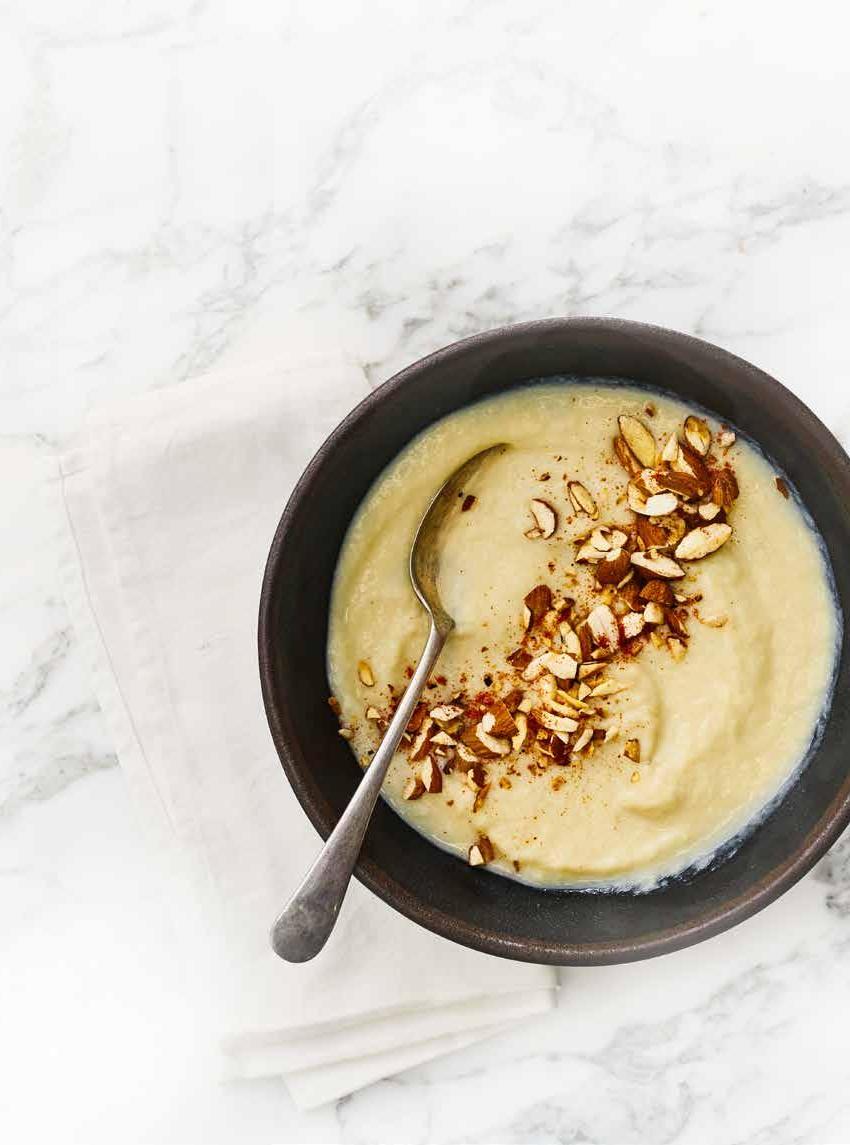
10 minute read
ROSIE’S SEASONAL STARS
ROSIE’S SEASONAL STARS
ALL-PURPOSE PEARS
With a mellow sweetness, this orchard fruit works well in sweet and savoury dishes. Rosie Birkett shares her favourite new ideas for cooking with pears photographs TOM REGESTER
Ithink I’ve underestimated the power of the pear in the past. It’s easy for them to be neglected come autumn when the British apples barrel in with their jazz hands, all crunch, juice and acidity. But this gentler, more mellow orchard fruit has unique charms that lend it not just to eating – ripe and juicy in its own right – but for teaming with other seasonal ingredients, too. There are many wonderful things you can do with pears, both sweet and savoury.
When we inherited our overgrown allotment from the plotholders before us, we were excited to discover a small Williams pear tree on it. Williams is one of the most iconic pear varieties, with a fat-bottomed bell shape, golden skin with red freckles, and juicy flesh. I had vague dreams about distilling my own Poire Williams to fuel future dinner party discos, but in fact, we’re yet to enjoy its fruits, thanks to the pilfering hands, claws or paws of some unknown predatory pear addict who manages to swoop in and harvest the bounty each year before we do.
We did plant our own pear tree in front of our London flat when we first moved in, but as yet, it’s only provided one mean, rock-hard fruit. My hope is to one day grow an abundantly fruiting pear tree of my own – espaliered, like they do in walled castle gardens. If you’re lucky enough to have your own, these recipes will provide you with some new inspiration for how to use its fruit. If you’re buying pears to use, look out for the superior-flavoured Doyenne Du Comice, Conference or Concorde, as well as the Williams.
There’s an unexpected complexity to the flavour of really good pears that thrills me once the season is upon us. Far from one-dimensional, they offer aromatic, beautifully balanced notes. This, along with their honeyed sweetness and sometimes slightly astringent skin, means they pair well not just with creamy, sharp cheeses and acidic fruits, but with the tannic notes found in walnuts, bitter leaves and chocolate.
A classic combination is the French salad of pear, chicory, walnut and roquefort. It’s something I’ll always order if I see it on the menu in a brasserie or bistro. It’s an inspired balancing act of flavour and texture, and it’s certainly influenced the tart here, though I’ve used gorgonzola dolce as I prefer its butteriness and acidity with the pears. There are ground walnuts in its short pastry, as well as walnut halves in the tart, plus earthy chard leaves. The roasted pears offer a wonderfully sweet contrast. The slight fruitiness of gorgonzola works well, but it’s also good with other washed-rind cheeses, such as livarot, or British riseley.
While I’ve often roasted pork with apples in the past, pears are a beautiful accompaniment to sumptuous roasted belly – the sweet fat renders and melds with the cider, star anise and fruit in the recipe to create something rib-sticking and fragrant. The crumble recipe, also on that page, is autumn comfort in a dessert. Blackberries bring a sharpness and burst of purple that melds with the buttery, soft pear, while the topping is spiked with warming spices and crunchy nuts and seeds. The bay-infused custard is an optional extra that adds one final aromatic flourish, and elevates this to a dinner-partyworthy sweet.
Good Food contributing editor Rosie Birkett is a food writer and stylist, and a regular on BBC One’s Saturday Kitchen. Her latest book, The Joyful Home Cook, is out now (HarperCollins). @rosiefoodie
Pork belly with bay, cider & pears

Pear, walnut & blue cheese tart

This makes an ideal starter, lunch, light supper, or cheese course.
SERVES 6 PREP 25 mins plus 1 hr chilling and cooling COOK 1 hr 5 mins MORE EFFORT V
For the pastry 50g walnut halves 150g plain flour 80g cold unsalted butter, chopped 1 egg yolk For the filling 1 tbsp butter 1 tbsp olive oil, plus an extra 1-2 tsp 4 shallots, sliced into half-moons small bunch of sage, finely chopped 200g chard, stalks finely chopped and leaves roughly chopped 2 pears, halved, cored and sliced 3 large eggs grating of nutmeg 150g crème fraîche 150g gorgonzola dolce or vegetarian alternative, torn into bite-sized pieces 50g walnut halves 1 To make the pastry, blitz the walnuts in a food processor until they resemble breadcrumbs. Add the flour and a large pinch of salt. Pulse briefly to combine, then add the butter and pulse until it resembles large crumbs. Add the egg yolk and pulse until the dough comes together (add 1 tbsp cold water if it seems dry). Squash the dough into a disc, then wrap in baking parchment and chill for at least 30 mins. 2 Heat the oven to 180C/160C fan/ gas 5. Heat the butter and 1 tbsp oil in a heavy-based frying pan or skillet over a medium heat, and cook the shallots, sage and chard stalks for 5-8 mins until soft and starting to caramelise. Add the chard leaves and continue to cook until wilted, then remove from the heat. 3 Put the chilled pastry between two sheets of baking parchment and roll out to the thickness of 2.8mm. Use it to line a 20cm tart tin, then chill for 30 mins until firm. Toss the pear slices in 1-2 tsp oil on a baking sheet. 4 Scrunch up a sheet of baking parchment and use it to line the pastry case, then fill with baking beans. Bake for 15 mins, alongside the pears. Remove both from the oven. Remove the parchment and beans from the pastry case, then bake for 8-10 mins more, until the bottom is golden and crisp. 5 Lightly beat the eggs in a bowl, then season with some nutmeg and whisk in the crème fraîche. Stir in the cheese. Pour half the mixture into the tart case, then layer in two-thirds of the chard mixture. Arrange the roasted pear slices and remaining chard mix on top, then pour over the remaining custard. Dot over the walnut halves, then bake for 28-30 mins, or until golden and cooked through. Leave to cool for 20 mins, then slice and serve.
GOOD TO KNOW calcium • 1 of 5-a-day PER SERVING 614 kcals • fat 48g • saturates 23g • carbs 28g • sugars 7g • fibre 4g • protein 16g • salt 0.8g
Pear & blackberry crumble with bay leaf custard

Pork belly with bay, cider & pears
SERVES 6 PREP 15 mins plus 4 hrs curing and resting COOK 2 hrs EASY
P
11/2 kg pork belly, skin scored rapeseed oil, for drizzling 1 carrot, roughly chopped 1 celery stick, roughly chopped 1 white onion or 4 shallots, roughly chopped 1 star anise 3 bay leaves 2 pears, cored and quartered 200ml non-alcoholic dry pear cider 1 tbsp plain flour roast potatoes and steamed greens, to serve (optional) For the rub 3 tsp sea salt flakes 1 tsp fennel seeds 1 tsp white peppercorns
1 To make the rub, put the ingredients in a pestle and mortar and crush together. Reserve 1/2 tsp of the rub and set aside. Cut some slashes into the underside of the pork using a sharp knife, then pat the rub all over the flesh, avoiding the skin. Put on a plate, skin-side up, and leave to cure in the fridge for at least 3 hrs. 2 Remove the pork from the fridge at least 30 mins before cooking so it comes to room temperature. Heat the oven to 180C/160C fan/gas 4. Pat the reserved rub over the pork skin, and rub a little rapeseed oil all over. Put the carrot, celery, onion, star anise and bay leaves in a large flameproof roasting tin. Pour over a small glass of water, then place the pork on top, skin-side up. Roast for 1 hr 30 mins. Arrange the pears in the tin around the pork, coating them in the juices, and pour the cider into the tin, avoiding the pork skin (if the skin gets wet, you won’t end up with crisp crackling). Turn the oven up to 220C/200C fan/gas 7 and roast for a further 15-20 mins. The pork skin should be crisp, and the pears glazed in the juices. Remove the pork from the tin. Leave to rest for 45 mins. 3 Transfer the pork to a serving platter. Gently lift the pears out of the tin and arrange next to the pork. Discard the carrot, celery, onion and bay, then skim some of the fat from the surface of the juices (you can transfer this fat to a jar and use it for cooking roast potatoes, or making rillettes, and more). 4 Put the roasting tin with the skimmed juices on the hob over a medium heat. Sprinkle in the flour and whisk it into the juices until smooth and thickened. Add a splash of hot water if it becomes too thick. Pour the gravy into a warm jug. Cut the pork into portions with a sharp knife, then serve with the roasted pear quarters, the gravy, and some roast potatoes and steamed greens, if you like.
PER SERVING 547 kcals • fat 37g • saturates 12g • carbs 9g • sugars 6g • fibre 2g • protein 42g • salt 2.8g
Pear & blackberry crumble with bay leaf custard
SERVES 6 PREP 15 mins plus standing COOK 45 mins EASY V
For the filling knob of butter, plus extra for the dish 6 large pears (Williams, Conference or Comice), peeled, cored and each sliced into 6 thick wedges 100g light muscovado sugar ½ lemon, juiced pinch of ground cinnamon 100g blackberries For the custard (makes 500ml) 2 egg yolks 225ml whole milk, plus a splash 1½ tbsp golden caster sugar 3 fresh bay leaves For the crumble topping 120g plain or spelt flour 140g light muscovado sugar 100g jumbo oats 50g pumpkin seeds 40g flaked almonds 40g skinless blanched hazelnuts, chopped ½ tsp ground cardamom ½ tsp ground ginger 150g unsalted butter, melted 1 First, make the custard. Whisk the egg yolks in a bowl until just broken up – they shouldn’t be frothy. Pour the milk and sugar into a saucepan and warm over a low heat, stirring to dissolve the sugar, until almost boiling. Add the bay leaves, remove from the heat, and leave to infuse for 10 mins. If the milk mixture has cooled after this time, briefly warm it up again until just steaming, then remove from the heat. Discard the bay leaves and pour a little of the mixture into the whisked egg yolks. Whisk in the splash of milk, then pour the yolk mixture into the milk pan, whisking continuously to combine. Cook over a low-medium heat, stirring constantly, until the mixture is thick enough to coat the back of a spoon, and silky smooth. Strain through a sieve and set aside. The custard can be served warm or cold – you can chill it at this stage, or set aside to reheat later. 2 For the crumble topping, combine the flour, sugar, oats, pumpkin seeds, almonds, hazelnuts, spices and a pinch of salt in a bowl, then pour over the butter. Mix well. Heat the oven to 200C/180C fan/gas 6. 3 Butter a large ceramic baking dish. Combine the pears, sugar, lemon juice, cinnamon and knob of butter in a medium pan, then set over a low heat. Cook for 4-5 mins, gently stirring, until the pears have released some juice and are slightly softened, but not falling apart. Remove from the heat and tip into the dish along with half the cooking juices released into the pan. Dot the blackberries among the filling. 4 Scatter the crumble topping all over the filling, then bake for 25-30 mins until golden, crisp and bubbling at the edges. Leave to stand for 10 mins before serving with the custard, alongside the remaining pan juices.
GOOD TO KNOW fibre • 1 of 5-a-day PER SERVING 813 kcals • fat 42g • saturates 19g • carbs 92g • sugars 64g • fibre 8g • protein 12g • salt 0.2g






